The Herald - 25 February 2019 - By Phil Miller, Arts Correspondent
IT is the largest single figure created by one of Scotland’s leading sculptors.
https://www.heraldscotland.com/news/17456540.from-paisley-to-indiana-scottish-sculptor-unveils-epic-new-work-for-the-university-of-notre-dame/?ref=twtrec/
The towering, 14ft sculpture of Leon Battista Alberti, one of the giants of Italy’s Renaissance, is currently in the studios of Alexander Stoddart in Paisley, waiting to be cast in bronze and cross the Atlantic to its ultimate destination.
The sculpture of the Italian architect, writer, poet and author is to be part of one of the US’s leading universities, the University of Notre Dame in Indiana.
There, the towering figure will be part of a rebuilt architecture department.
The sculptor, whose studios are located within the Paisley campus of the University of the West of Scotland, has shared an image of the sculpture, being worked on by studio assistants Lindsay McQuarrie and Zoe Roy.
With dividers in one hand, and a scroll in the other, Alberti, Mr Stoddart said, is looking at the remains of classical Rome - deep in the past - as well as looking into the future.
In a detail which alludes to the Scottish site of its creation, Alberti’s left leg is beside a Roman altar, to Diana and Apollo, which is part of the Hunterian Museum’s collections at the University of Glasgow.
The plaster statue will shortly be moved to Black Isle Bronze, where it will be cast in bronze, before it’s lengthy shipped journey across the Atlantic: it is due to be unveiled officially at the University of Notre Dame in the summer.
Mr Stoddart, known for his neo-classical sculptures - including David Hume and Adam Smith on the Royal Mile in Edinburgh, said it is the result of around two years of work.
He said: “It is a large work in contemporary terms, by real standards, it is not not that large, although it is a big work for me, and the tallest single figure.
“He has dividers in his hand - he is measuring the world. He is staring at Rome, and that is what is there in that block by his leg - so he is looking 1400 years back, but also to the future, back and forward at the same time.”
Mr Stoddart said he is also currently working on a figure, also for the US, that will be taller.
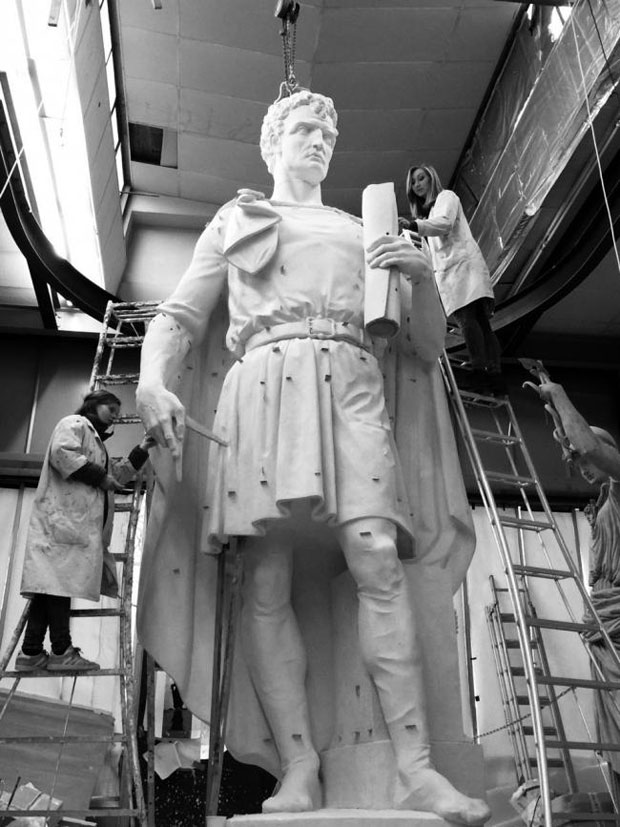
The sculptor noted that the figure of Albert (who lived from 1404 to 1472), simply clothed, is distant from the current “imperium of modernism.”
He addded: “The pathos of this work is that it is most distant from the trends of now - it is the most temporally alienated sculpture I have made.”
The artist said that Notre Dame’s School of Architecture, established in 1898, perhaps aptly, emphasises traditional architectural ideals and theories.
The architect John Simpson has designed the university’s new School of Architecture building, and has worked with Mr Stoddart before, notably the Queen’s Gallery at Buckingham Palace.
Mr Stoddart, born in 1959, studied at Glasgow School of Art and the University of Glasgow.
Bronze neoclassical sculpture designed by renowned Scottish artist - 20 November 2018
http://www.longwood.edu/news/2018/longwood-unveils-newest-joan-of-arc-monument/
The campus community gathered on a brisk Friday morning to get the first up-close look at Longwood’s towering new monument to Joan of Arc, the university’s patron hero who has inspired generations of students. The monument, Longwood’s third of the 15th-century French heroine, was installed Monday after more than three years of work by a renowned Scottish artist.
“A great work of art endures through time and inspires across horizons of years difficult to fathom,” said Longwood President W. Taylor Reveley IV, as he and Rector Marianne Radcliff ’92 dedicated the monument. “This majestic statue that we dedicate today will inspire us across all our years: Joan of Arc, poised forever young, in a moment of defiant triumph. She will see untold wonders as well as grief and woe, and stand as a point of reverence and hope for people who have long forgotten the work of the year 2018 that brought her here.”
At more than 15 feet tall, the heroic figure of Joan of Arc strikes an assertive pose and captures the historic woman at the height of her military prowess, raising the Siege of Orleans in 1429. Wearing a heavy suit of fanciful armor and wielding not only a legendary sword but also the French standard she is said to have favored, this vision of Joan of Arc stands in stark contrast to softer images of her in museums around the world. It stands at the southern end of Brock Commons, between Hull and Bedford halls.
“This vision of Joan of Arc embodies the spirit of Longwood, of our university, as we look out over the 21st century and beyond with our special call, with all we have been given in lives of citizen leadership,” said Reveley. “Joan of Arc here embodies the resolute and revolutionary grace that animates the alma mater.”
The new statue of Joan of Arc joins two other representations of the heroine, both prominent fixtures on campus. Known affectionately as Joanie on the Stony and Joanie on the Pony, they reside in Ruffner Hall, where hundreds of students pass each day, and have come to be known as much as symbols of Longwood as depictions of the legendary figure.
Radcliff recalled her own relationship with Joan of Arc, first cultivated as a child in Sunday school, growing as a Longwood student and deepening since then.
“As tragic as her ending was, tried for witchcraft, heresy and dressing like a man of all things, her accomplishments are nearly unmatched,” said Radcliff. “She taught me what’s possible. It’s a concrete lesson that tasks that seem insurmountable aren’t necessarily so. That because people say you cannot is no reason to turn back. These are the life lessons worth learning.”
As the ceremonial ribbon was cut, more than a hundred people in attendance crowded around the granite-and-limestone exedra, marveling at the figure’s intricate details.
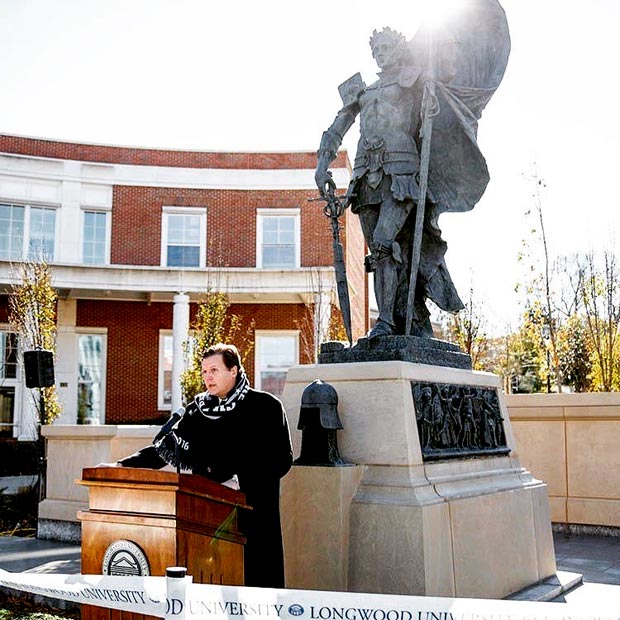
Earlier in the week, sculptor Alexander Stoddart traveled to Farmville from his studio in Scotland to supervise the statue’s installation and deliver a lecture on the inspiration for and production of the figure.
“Strange things happen within the monument,” the artist said in his Monday night lecture in Blackwell Ballroom. “For instance, the flagpole has this strange twist going up it—various whiplashing actions. Everything in this monument has to be seen to have a life of its own, or at least a will or a tension of its own. Her hands are nude, but come out of a gauntlet. This is fairy sculpture, really. It’s all supernatural—it’s an image of the fairy queen that can stand for so many types of Joan of Arc.”
Stoddart is one of the world’s foremost neoclassical monumental sculptors. He has been active since the early 1980s, but began working on public monuments about a decade later. Some of his most celebrated pieces are of philosophers Adam Smith and David Hume, which stand in the Scottish capital, Edinburgh, Stoddart’s hometown.
In 2008, he was named the Queen’s Sculptor in Ordinary in Scotland, a lifetime appointment and the highest honor a Scottish artist can receive. In 2012, he was elected a Fellow of the Royal Society of Edinburgh. The historic figures in his monuments often take on a heroic realism, with noble postures and metaphoric elements.
The new monument was conceived during the 2015 Master Plan as a nod to Longwood’s history of public art along Brock Commons and longstanding relationship with Joan of Arc. As conversations continued, word made it to Stoddart that Longwood was considering the project. The sculptor was immediately intrigued by the idea.
“It has to give a shock,” he said. “What we’re fed up with doing is compliant sculpture. Sculpture that wouldn’t say boo to a goose. Because what we’re dealing with are images of people that said a mighty boo to a goose. Joan of Arc, if she had been a compliant creature, wouldn’t have gotten anywhere.”
His vision was immediately of the androgynous, assertive figure that now stands on Brock Commons. During his lecture, he acknowledged the differences between his Joan of Arc and other representations of the inspirational woman, especially in some of the more masculine elements of the monument including her codpiece and muscular, imposing frame.
“If we object to this on the bounds of decency, whose side are we really on?” he asked. “Her trial is one of the most documented trials of all. She’s accused of heresy, witchcraft, insubordination, insurrection—the whole gamut. But the one point they keep coming back to her on was the fact that she refused to wear women’s clothes. She insisted constantly on wearing men’s clothing. If we object to these decisively masculine details, we are taking the side of her accusers.”
As university traditions go, Longwood’s devotion to Joan of Arc is remarkable in its endurance.
In the early 1900s, as many around the world marked the 500th anniversary of her birth, Joan of Arc became a special symbol for the university, anchored by a gift from the class of 1914, a plaster cast of a Henri Chapu sculpture that is now affectionately known on campus as Joanie on the Stony. Some attribute the idea to a graduation speech by class president Maria Adams Bristow Starke, in which she urged classmates to take inspiration from the French heroine. Others point to longtime English professor Dr. James Grainger as making the initial suggestion that Joan of Arc become a symbolic figure for what was then a normal school.
The relationship that began in 1914 was further solidified in 1927 when another Joan of Arc sculpture was purchased, this time a recast of Anna Hyatt Huntington’s celebrated work, which has been called “one of the finest equestrian monuments in the United States.” In keeping with tradition, the student body has referred to her as Joanie on the Pony ever since.
In his remarks at Friday’s dedication, Reveley noted that powerful thread running through generations of Longwood students. To the current Longwood students in attendance, he issued a call to remember and draw inspiration from Longwood’s patron hero.
“In your lives and careers, as you create and sustain and lead communities, think of the power of beauty itself to inspire, and galvanize and weave it into your work,” he said. “And for fortitude, and to fill the soul throughout all the years, you can return to the alma mater, to the very place we stand now, consecrated with the presence of our patron hero who in the midst of victory remains inaccessible to vanity and hate, who in the midst of popular enthusiasm lives in humility and prayer, who in the universal crush of ambition covets neither profit nor honors.”
The Times - 18 January 2018 - Mike Wade
The present cast is number 5 of an edition of 10 cast by the Morris Singer Foundry in 1987
aluminium, with a stainless steel armature, raised on a bronze scroll, resting on a bronze fountain base
Eros: 250cm., 98 3/8 in.
base: 285cm., 112 1/4 in.
http://www.sothebys.com/en/auctions/ecatalogue/2019/fine-art-society-l19350/lot.133.html
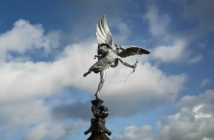
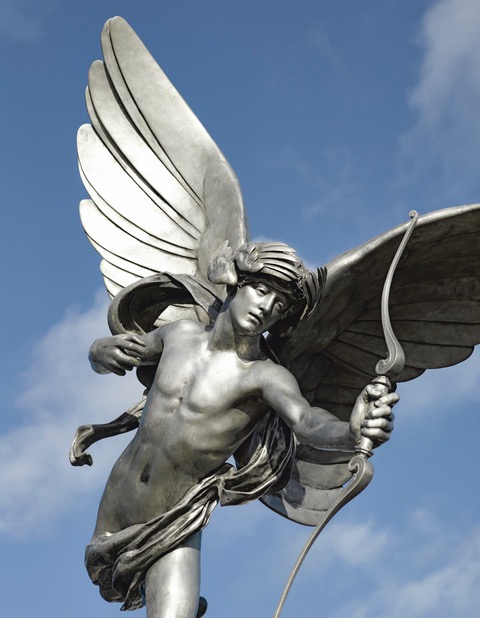
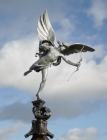
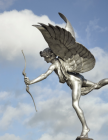
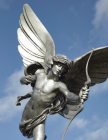
The Times - 18 January 2018 - Mike Wade
Three bronze statues have begun an epic voyage across the Atlantic where they will honour the Scot who helped secure Chilean independence in time for the country’s bicentenary.
Leonie Gibbs, a Highlands sculptor, was commissioned by Manuel Ibañez, a businessman, to produce the dashing artworks featuring Admiral Thomas Cochrane.
Mr Ibañez told her that the works should have “a powerful heartbeat” to reflect the admiral’s pivotal role in securing his country’s nationhood. Cochrane was in charge of the country’s navy
and secured decisive victories over Spanish forces.
The three pieces will be installed at the Chilean naval academy, in Valparaiso; at Mr Ibañez’s farm, near Santiago; and, fittingly, in the main square of Cochrane, a Patagonian town at the head of Lake Cochrane.
A fourth statue has been made for Lochnell Castle near Oban, home of the 15th earl of Dundonald, a proud descendant of the admiral.
Gibbs said the commission had “come from nowhere”.
Mr Ibañez visited Scotland three years ago on the trail of monuments to the Chilean hero. An Edinburgh gallery recommended him to the present earl,
who in turn put the businessman in touch with the sculptor, who was a childhood friend.
The artist, who is based in Cupar, Fife, recalled meeting Mr Ibañez for the first time over breakfast in London.
A project that had begun as a bust of the admiral rapidly turned into “a very exciting commission” for the statues, each of which is one-and-a-half times
life size. Though coy about the fee, Gibbs, 57, said that she had earned “enough for a cruise”.
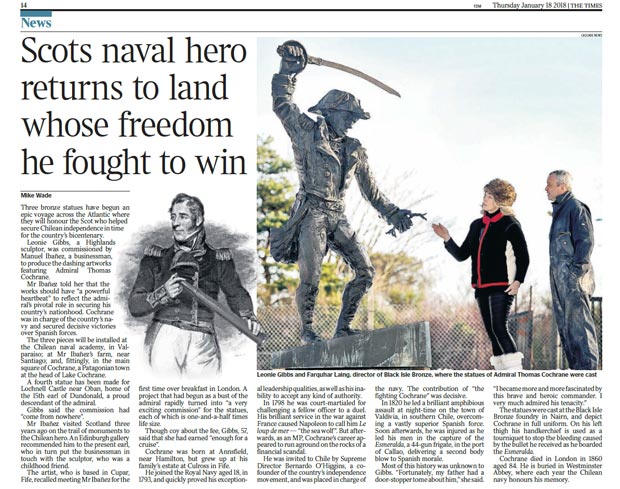
Cochrane was born at Annsfield, near Hamilton, but grew up at his family’s estate at Culross in Fife.
He joined the Royal Navy aged 18, in 1793, and quickly proved his exceptional leadership qualities, as well as his inability to accept any kind of authority.
In 1798 he was court-martialed for challenging a fellow officer to a duel. His brilliant service in the war against France caused Napoleon to call him Le loup de mer — “the sea wolf”. But afterwards,
as an MP, Cochrane’s career appeared to run aground on the rocks of a financial scandal.
He was invited to Chile by Supreme Director Bernardo O’Higgins, a co-founder of the country’s independence movement, and was placed in charge of the navy.
The contribution of “the fighting Cochrane” was decisive. In 1820 he led a brilliant amphibious assault at night-time on the town of Valdivia, in southern Chile, overcoming
a vastly superior Spanish force.
Soon afterwards, he was injured as he led his men in the capture of the Esmeralda, a 44-gun frigate, in the port of Callao, delivering a second body blow to Spanish morale.
Most of this history was unknown to Gibbs. “Fortunately, my father had a door-stopper tome about him,” she said. “I became more and more fascinated by this brave and heroic commander.
I very much admired his tenacity.” The statues were cast at the Black Isle Bronze foundry in Nairn, and depict Cochrane in full uniform. On his left thigh his handkerchief is used as a
tourniquet to stop the bleeding caused by the bullet he received as he boarded the Esmeralda.
Cochrane died in London in 1860 aged 84. He is buried in Westminster Abbey, where each year the Chilean navy honours his memory.

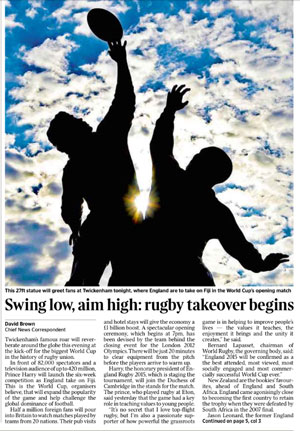
The Times - 18 September 2015
The Rugby World Cup has gripped the public's imagination.
Several National newspapers have featured the famous Core Values sculpture, outside of the Twickenham stadium.
The 27ft tall bronze sculpture, depicting a rugby line-out, welcomes' fans to Twickenham Stadium from its spot on the South Stand piazza.
It is being seen by millions across the world as the stadium hosts the opening and final matches in the 2015 Rugby World Cup.
Created by Pop artist and sculptor Gerald Laing, the bronze of five rugby players was unveiled in 2010, and engraved around the bottom of the statue are the five core values of the game of rugby union - teamwork, respect, enjoyment, discipline and sportsmanship - to ensure they have a lasting legacy at the home of England rugby.
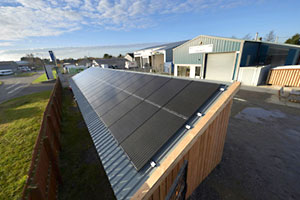
February 2015
We are delighted to announce that we are now the first solar powered bronze foundry in
the UK.
We recently installed solar panels, and now this renewable energy source is providing
‘clean’ energy for all of the foundry’s day to day needs. We feed back any excess into the
National Grid.
The panels are installed on the roof of a brand new multi-car port, where
there will be a power point for electric cars next year.
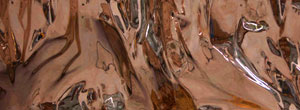
We hope you like our new and much improved website. We've revamped the design
to make it user friendly on a variety of platforms.
Thanks to photographer Christine
Spreiter for an array of stunning foundry shots, including the one on the homepage,
a close-up detail of a bronze table, made for design company Based Upon.
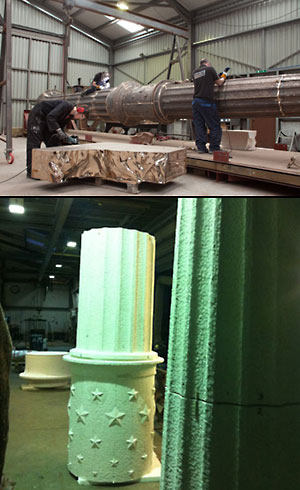
This is an in-progress shot of one of our biggest commissions to date - a 40 foot neoclassical bronze
column topped by a statue of Eos, Greek goddess of the Dawn. Designed and sculpted by Alexander
Stoddart, the column is destined for a large property development in Texas.
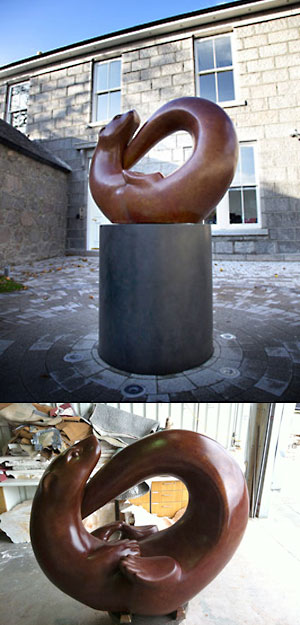
We completed this magnificent large scale otter by Laurence Broderick for Aberdeen
Drilling Consultants Ltd. for their new headquarters, a part of which is the old toll gate
into Aberdeen, now preserved and integrated into the complex. The Maxwell Otter,
placed in the courtyard, heralds this transformation and improved building.
A few words from sculptor Laurence Broderick, about the work
"Douglas and Faye Hay, who commissioned the work, had seen my sculptures at the Isle of Skye
exhibitions and longed to have one of my otter sculptures.
My association with otters goes back to 1978 on Skye, where Gavin Maxwell's book 'Ring of Bright
Water' inspired me to carve stone otters. My interest in these versatile creatures grew.. their
movement and flexibility, the constantly changing shapes which resulted in the simplification of their
bodies [in my work]. The movement of this bronze otter is expressing my desire to create movement,
as in most of my sculptures..
I modelled the Maxwell Otter in plaster, 100 cm in height and 130 in length, in my studio in
Cambridgeshire, where Douglas and Faye first saw it, still in an unfinished state.
Once the final finish was achieved the otter was moved to Nairn where it was cast into bronze to a
very high degree of excellence.
The Maxwell Otter.. reminds us of the man who influenced my work and to whom I owe so much in
my life, even though I never had the chance to meet him; Gavin Maxwell, whose centenary of his birth
we are celebrating this year."
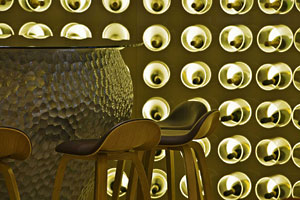
We recently completed a 5 metre long asymmetrical aluminium bar for design company Grapes Associates, as part of their unique designs for a brand new global flagship store for jewellery company Pandora on Oxford St, London. The store opened with panache in September with Kelly Brook among the glitterati in attendance.
The curved bar had a complex texture inspired by the dimpled texture of Pandora’s signature jewellery designs; it was cast in 9 pieces, welded together then polished to a satin finish. A specialist spray lacquer was then applied.

Black Isle Bronze cast a set of 16 elegant dining chairs in aluminium for Greenwich based design company Splinterworks.
The design was inspired by an elephant's form and finished in gold leaf.
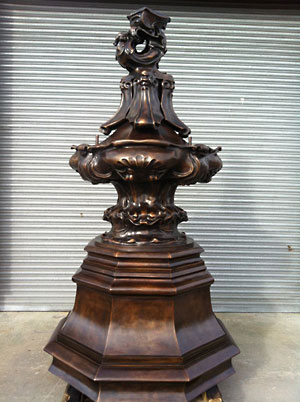
We created a new bronze cast of the original base designed for the sculpture known as Eros (actually Anteros , or the Angel of Christian Charity), which stands in Piccadilly Circus, for the Fine Art Society, for the 12th Earl of Shaftesbury; the original was erected in 1892 in memory of his ancestor, the 7th Earl..
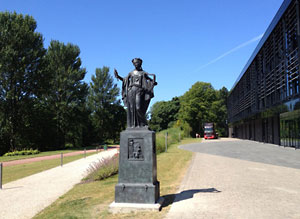
A bronze figure of Coila, also by Alexander Stoddart and cast at the foundry earlier this year, has been unveiled at the University of the West of Scotland’s Ayr campus in Paisley. Coila was the muse of Robert Burns she features in Burns’ poem ‘The Vision’ acting as Burns’ inspirational force, driving him on according to his true nature and vocation. The work has been created by Stoddart, whose studio is based at the University’s Paisley Campus, to capture the essence of the ambition and drive of UWS. The work, which is 15 ft high, comprises the statue and a decorated bronze plinth.
It was officially unveiled by Alice McDaid, wife of Professor Seamus McDaid CBE, who retired as Principal & Vice Chancellor in September, Professor McDaid said: “We are delighted to have officially unveiled this work at our Ayr Campus. Alexander Stoddart is one of the country’s most respected sculptors and this statue is not only a hugely important addition to the grounds of our Ayr Campus and will be enjoyed by all who work on, study at and visit the campus, but it will provide an important cultural landmark for Ayrshire itself.”
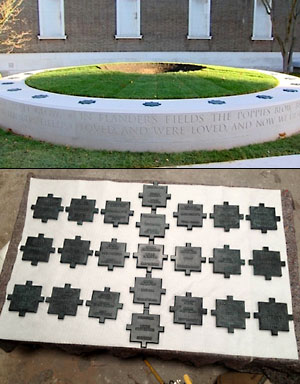
Black Isle Bronze was chosen to create 23 bronze crosses for Sir Robert McAlpine as part of an important new memorial to the battles fought in Flanders during the First World War, partly funded by the Government of Belgium, in recognition of the loss of British lives during that conflict.
The circular monument has been erected as part of a ‘memorial garden’ at Wellington Barracks on Birdcage Walk in London in time for the Centenary of the beginning of the war next year. Belgian landscape architect Piet Blankaert was responsible for the design which consists of a seven metre diameter ring of Portland stone with crosses inscribed with the names of each battle inserted at regular intervals around it and the famous poem In Flanders Fields by Lt Col John McCrae engraved around the outer side.
http://www.bbc.co.uk/news/uk-25153022 http://en.wikipedia.org/wiki/In_Flanders_Fields
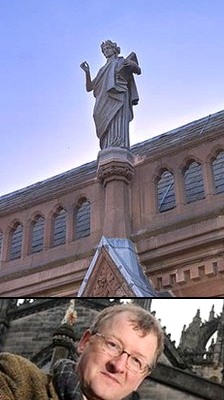
10 October 2013 Courtesy of The BBC website
Made by Alexander Stoddart, it represents Clio - who is the muse of History in Greek mythology. In 2008 Mr Stoddart was made Sculptor in Ordinary to The Queen in Scotland.
The sculpture replaces the original figure of History by the sculptor William Birnie Rhind, which weathered beyond repair and was later removed. Mr Stoddart's new figure is cast in aluminium, stands almost two metres tall and weighs 85kg.
An exhibition, Alexander Stoddart: Making History is at the Queens Street gallery from Saturday until 28 September 2014.
The exhibition shows the technical process to create History through the artist's drawings and photographs from his studio at the University of the West of Scotland and at the Black Isle Bronze foundry in Nairn where the sculpture was cast.
Mr Stoddart has sculptures of David Hume and Adam Smith on The Royal Mile and the physicist James Clerk Maxwell on George Street. Christopher Baker, director of Scottish National Portrait Gallery, said: "This wonderful new sculpture is sited serenely above the facade of the gallery, both making a statement and being entirely sympathetic to its context, one of Scotland's greatest 19th Century buildings.
Victorian period
"It is the first enrichment of this sort which has been installed on the gallery since the Victorian period. "The related exhibition will illustrate in a compelling manner the extraordinary commitment that Alexander Stoddart made to this high-profile commission."
Mr Stoddart, said: "This tremendous commission, to complete the sculpture scheme of the Portrait Gallery, gave me the opportunity to pay homage to some of the great late 19th Century artists whom I have admired since my earliest days as a sculptor. "It has been a weighty honour to have been allowed to work in collaboration with these long-dead men, and a pleasure working with the people at the Scottish National Portrait Gallery who are all alive and thriving in one of the greatest National-Romantic buildings in the British Isles.
"I should like to thank them all, and to thank my studio assistants in Paisley, and the foundry-workers in Nairn, who worked so diligently with me to achieve this end; a simple little figure, standing where she ought, with the clouds behind her."

22 February 2013
Two senior RAF figures from Moray’s past and present are officially unveiling a unique sculpture of a Tornado at Moray’s leading international business location - the Enterprise Park Forres today (Friday 22 February).
Wing Commander David Arthurton from RAF Lossiemouth and former Group Captain James Johnston - the last Station Commander at RAF Kinloss prior to its transition to Kinloss Barracks - will officially reveal the 4 metres bronze piece which was designed and created by Scotland's largest fine art foundry, Black Isle Bronze, based in Nairn.
Commissioned by Highlands and Islands Enterprise (HIE) in 2009 the £47,800 sculpture has been placed at the Enterprise Park Forres, where it can be enjoyed by the many international investors, local workers, and visitors coming to the high quality 100 acres site.
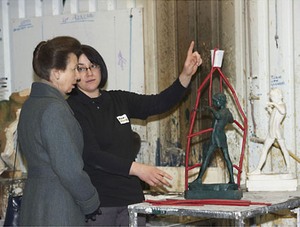
06 December 2012
The Princess Royal, HRH Princess Anne, paid a visit to Scotland’s leading fine art foundry, Black Isle Bronze in Nairn, yesterday (5 December).
She was received by the Lord-Lieutenant of Nairnshire, Ewen Brodie, the Provost of Nairn, Elizabeth Macdonald, and the Director of Black Isle Bronze, Farquhar Laing.
Farquhar Laing said, “I’m delighted that the Princess Royal has chosen to visit Black Isle Bronze. We’re one of the best known bronze foundries in the UK; the quality of our work speaks for itself, we’re equipped to take on complex large scale projects with confidence, and most importantly, Black Isle Bronze has a technically brilliant and dedicated team. The Royal visit is a great endorsement of this."
The Princess met foundry staff and learnt more about the complex bronze casting process and its history, and viewed the foundry’s latest projects, which include a memorial to the racehorse Sadler’s Wells and a 3m-long model of a Tornado jet.
She then unveiled a plaque – bronze, of course – to commemorate her visit, and was presented with a bouquet by Farquhar’s six year old daughter Madeleine.
Professor Alexander Stoddart, Sculptor in Ordinary to the Queen in Scotland and one of the foundry’s most important clients, was also there to greet the Princess Royal, along with other clients and suppliers. This included Highlands and Islands Enterprise (HIE) which has worked closely with the business for the past 10 years.
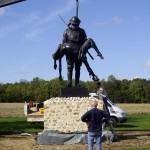
http://croixrougefarm.org/the-sculpture/
The bronze casting was done by the Black Isle Foundry located in Nairn, near Inverness.
Moulds of the clay model were made in the artist studio in Warickshire, and sent to Scotland. Metal founder Farquhar Laing and his highly skilled team of craftsmen, turned the work of James Butler into this splendid bronze statue.
Black Isle Foundry delivered the Rainbow Division Memorial statue to the Royal Academy in London for the Summer Exhibition and will install it this fall on its permanent site, at the Croix Rouge Farm in France.
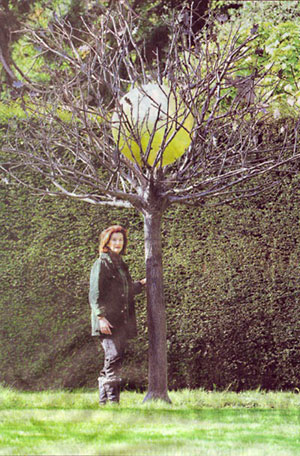
FRIDAY, APRIL 29, 2011 Inverness Courier By Rosemary Lowne
A STRIKING bronze sculpture created a spectacle on Tuesday when it was lowered by helicopter into the symbolic Garden of Eden at Cawdor Castle.
The Tree of Life, which weighs over 800 kilograms and cost nearly £100,000, was designed by Isle of Arran artist Tim Pomeroy after he was commissioned by Dowager Countess Angelicka Cawdor.
"It was absolutely wonderful," she said. "It has been a long time in the planning so it was wonderful to see;it as it's extraordinarily beautiful."
The eye-catching 14ft by 12ft sculpture took 18 months to create and boasts 100 leaves and a bronze sun which is covered in 24-carat gold leaf.
"We are delighted as we have had a good response from people who have seen the sculpture" Lady Cawdor added.
After being cast at Black Isle Bronze in Nairn, the tree was carefully lowered onto a 2ft square plinth by a crew from Dalcross-based PDG Helicopters.
Visitors to the garden will be able to look for planetary symbols depictlyzg Venus, Jupiter, Mars and Saturn which will are visible on the tree.
Looking to the future, Lady Cawdor is already planning to comfhission two more sculptures, one for the Maze Garden and the other for the Flower Garden.
"The sculpture in the maze will be homage to the minotaur, a Greek
mythological creature with the head of a bull on the body of a man" Lady Cawdor explained.
"I have asked an American sculpturist to produce drawings and I will also ask other artists to come up with ideas."
One Scottish sculpturist has already been asked to come up with ideas for the Flower Garden sculpture and Lady Cawdor will also ask at least two other artists for their designs.
"The sculpture in the Flower Garden is very exciting," said Lady Cawdor. "We would like to have a beautiful sculpture which could also be used as a bird feeder."
Walled Garden history
The Walled garden is the oldest garden and was enclosed with walls and bastions in 1620 with fruit, flowers, vegetables and orchids growing in abundance. In 1981 Lord Cawdor decided to remodel the garden and plant a holly maze.
The pattern for this was taken from a design set in the mosaic floor of the ruined Roman villa of Conimbriga in Portugal and which in classical form depicts the Minotaur's labyrinth at Knossos in Crete.
Cawdor Castle also has a Wild Garden and a Flower Garden.
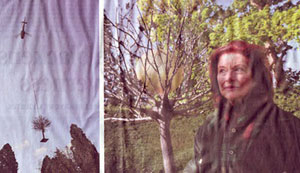
FRIDAY, APRIL 29, 2011 Press & Journal BY MEL FAIRHURST
The sun will always shine in the gardens of a historic Highland castle following the installation of a £100,000 bronze sculpture.
Due to its near one-ton weight, the Tree of Life - complete with sun - had to be lowered by helicopter into Cawdor Castle's Garden of Eden yesterday.
A crew from Dalcross based PDG Helicopters took a few minutes to transport the artwork from a field a few hundred yards away to its permanent home.
Anxiously watching was the Dowager Duchess Angelicka Cawdor, who commissioned Isle of Arran artist Tim Pomeroy to undertake her latest project. Lady Cawdor heaved a sigh of relief when the 14ft by 12ft sculpture - complete with about 100 leaves and bronze sun which is covered in 24carat gold leaf - was successfully lowered on to a 2ft square plinth, which is being supported by five tons of concrete underground.
Eagle-eyed visitors will also spot planetary symbols depicting Venus, Jupiter, Mars and Saturn somewhere on the tree.
Lady Cawdor said: "I was worried about the taller trees as it was being airlifted in, but there was no damage. This is the latest sculpture in a series which make up the symbolic gardens. I felt the Tree of Life is very symbolic in many religions, like Kabbalah, and it has mystical values.
In the middle is the symbol of the sun in homage to the giver of all life. It looks fantastic, I am really pleased with it."
The project has been developed over the past 18 months and took Mr Pomeroy about four months to complete.
The tree was cast at Black Isle Bronze in Nairn.
Mr Pomeroy said: "It was the biggest commission for me both financially and physically. I am delighted with it and it looks wonderful in the garden and it will look different all the time in the different weather. It is great for me as 100,000 people will see it every year and, who knows, perhaps my next commission will be from Madonna, who is interested in Kabbalah."
Black Isle Bronze owner Farquhar Laing said: "It looks beautiful and it really has been a privilege to have put this piece in this ancient garden. There has been a garden here for 600 years and this sculpture will outlast the current trees and will be here for a long time to come, probably another 600 years."
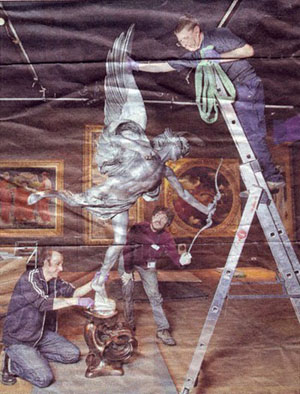
Wednesday 30 March 2010 - Evening Standard
STAFF have installed the centrepiece of a new exhibition at the Victoria and Albert Museum.
The aluminium cast of Eros, symbol of the Evening Standard and which draws millions of tourists to Piccadilly Circus every year, is to feature in an exhibition on the " aesthetic movement " .
The original Eros was created in the 1890s as a monument to Victorian philanthropist Lord Shaftesbury by sculptor Alfred Gilbert.
The exhibition, which opens on Saturday, explores " the cult of beauty" as promoted by Oscar Wilde and artists William Morris and Gabriel Dante Rossetti.
The show, The Cult of Beauty: The Aesthetic Movement 1860-1900, is the first to examine fully the aesthetic movement and is the next in the V & A's series on - important movements. It will guide visitors through the last four decades of the 19th century when many writers, artists and designers believed in living life as beautifully as possible.
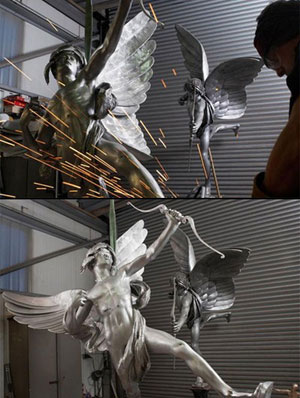
Simon Tait - for The Times
The last Eros is emerging in the Black Isle Bronze foundry under the hands of the metal founder Farquhar Laing. It is the twelfth and final cast of the Alfred Gilbert statue that was unveiled in Piccadilly in 1893 as part of the memorial fountain to the Earl of Shaftesbury.
The new Eros is destined for the Victoria & Albert Museum's exhibition The Cult of Beauty: The Aesthetic Movement in Britain 1860-1900 , between April and July next year, having been commissioned by the Fine Art Society (FAS), which will lend it to the museum. The exhibition will also travel to Paris and San Francisco.
The 15 moulds of the separate parts of the piece had been found in the V & A's stores 25 years ago by the curators of a Royal Academy exhibition devoted to Gilbert, and the Fine Art Society paid for their restoration in return for a licence to make no more than ten casts from them. Although the moulds will not be broken, Simon Edsor, director of the FAS, said that they could never be used again. Seen in the background is one of the private castings borrowed by Laing to ensure the correct patina is found.
The Piccadilly Eros was the only one to be cast originally, although one other was made in 1929 for Sefton Park in Liverpool. Both statues have been extensively restored over the years, with most of the armature of the London version having to be replaced in the 1990s when it was found to be rusty. The statue was actually an experimental piece for Gilbert, the first public sculpture to be made from the then newly discovered metal, aluminium. He found that the posture of the figure, leaning forward and balanced on the toes of a single foot, could not be sustained in the usual bronze because it would be too heavy. The new metal also gave Gilbert the patina effect of silvery brightness that he wanted.
When the moulds came to light in 1985 they were put on display in the RA exhibition, but no casts were made from them at that time. The new generation of casts emerged gradually over the ensuing decades, and of the nine already made eight were private commissions to adorn gardens and atriums out of the general gaze. Only one is on public view, at the Art Gallery of South Australia in Adelaide.
Eros itself has an interesting history. Made by Gilbert to be the essential part of London's tribute to the humanitarian philanthropist Lord Shaftesbury, it took him five years to complete the commission only for him to fall out with the memorial committee; he refused to attend the unveiling. When the statue was finally revealed, many were outraged that he should be remembered by the image of such an overtly voluptuous Greek mythical character, which gave the word "erotic" to the English language.
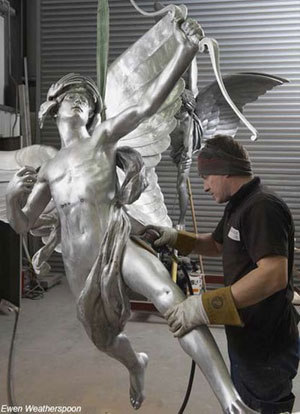
Louise Jury, Chief Arts Correspondent - London Evening Standard 23.11.10
A replica of Eros is finished at the Black Isle Bronze fine art foundry in the Highlands. The cast of the Piccadilly Circus sculpture is to go on display at the Victoria and Albert Museum
in April.
It was agreed when the rights to the work were sold 20 years ago that only 10 copies would be made and this is the last of them.
The statue by Sir Alfred Gilbert is also the symbol of the Evening Standard.
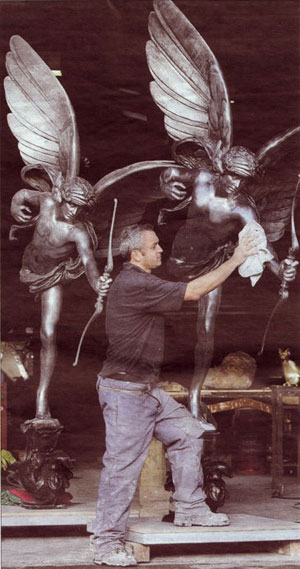
by Mel Fairhurst - Press and Journal - Tuesday Novenber 23 2010
One of London's best-loved sculptures has been recreated at a Highland foundry. The 10th cast of Sir Alfred Gilbert's iconic Eros sculpture in Piccadilly Circus has been produced in aluminium at Black Isle Bronze, based at Nairn.
The team used a mould from the original work of art to create the life-size piece which cost thousands of pounds and took six months to produce.
It was commissioned by the Fine Art Society in London and will be displayed at the Victoria and Albert Museum (V & A) in the capital in April next year and will then be showcased at the Musee d'Orsay in Paris later in the year. Owner and director of Black Isle Bronze, Farquhar Laing, said he was delighted when he was given the commission to recreate the sculpture, which depicts Anteros as " The Angel of Christian Charity" but is referred to as Eros.
The original version of the sculpture was erected in 1893 as part of the Shaftesbury Memorial Fountain and was one of the first statues to be cast in aluminium.
Mr Laing said: " I was really delighted by the Eros commission. To work with such an iconic sculpture, one so instantly recognisable to so many, is extraordinary."
The foundry has also taken on commissions for private clients, including comedian Rory Bremner and the late opera singer Luciano Pavarotti.
Mr Laing trained at the Morris Singer Foundry, which created the sculpture of Boudicca opposite the Houses of Parliament and the bronze lions in Trafalgar Square.
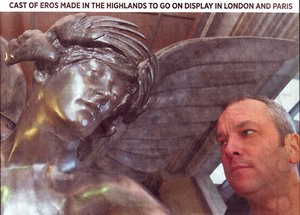
from The Scotsman Tuesday 23 November 2010
SCULPTOR Farquhar Laing gives a final polish to his casting of the iconic Eros statue originally created by Sir Alfred Gilbert.
The original work, on the left, is one of London's most photographed landmarks situated on the top of the fountain in Piccadilly Circus. Mr Laing's casting, which was created at Black Isle Bronze, in Nairn, after being commissioned by the Fine Art Society in London, will be displayed at the Victoria and Albert Museum and then in the Musee d'Orsay in Paris.
Black Isle Bronze is flying in the face of the recession: as orders increase in number, scale, and prestige, and with a client list spanning the globe from Japan to Newfoundland, owner/director Mr Laing plans to expand the foundry to double its size early next year.
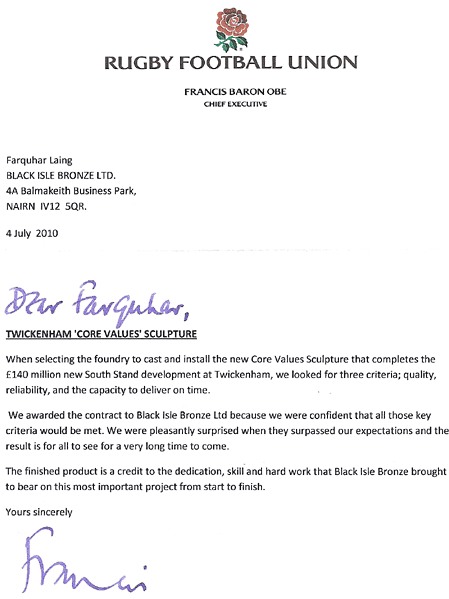

Northumberland Gazette - Thursday 22nd July 2010 - By ROBERT BROOKS robert.brooks@northeast-press.co.uk
At 14 feet high and brandishing a sword, he's certainly eyecatching as these exclusive pictures show.
And in just under a month, the magnificent new statue of legendary Northumbrian knight, Sir Henry "Hotspur" Percy, will be hoisted into place at the Duke's Memorial Garden on Pottergate in Alnwick, just yards from the castle which was his home more than six centuries ago.
The massive bronze was commissioned by the town's development trust and spearheaded by a committee of volunteers drawn from across the community.
Costing just under £60,000 - of which Hotspur's ancestor, Ralph, 12th Duke of Northumberland, footed a substantial portion - it will be finally unveiled on August 20, after almost two years of painstaking work by Elsdon-based sculptor Keith Maddison.
The attention to detail is eyewatering, with the statue capturing the essence of the medieval warlord right down to the rivets in his armour.
Keith even made each individual link of chainmail during the construction of the full-size clay model, which was used to create the moulds for Black Isle Bronze to cast the final version.
His passion has been fuelled not only by the local theme, but the reason behind the project - to celebrate 700 years of the Percy family in Alnwick in 2009.
"It has been an incredible privilege to work on a project like this, so close to home," said Keith, whose life-like works in bronze can be found across Britain.
Keith was recently at Black Isle Bronze to complete welding the individual parts of Harry Hotspur together- a curious historical twist, since the real man was quartered by King Henry IV following his death, aged around 37, in the Battle of Shrewsbury in 1403.
Although he initially hoped to complete the statue by September 2009, the development trust eventually allowed the project to develop at its own pace because of the immense amount of detail in it.
Trust manager Geoff Watson said: "It has been quite a journey to get to this point, from Keith's own conceptual drawings, to a two-foot-high clay model, followed by the full size clay and now the actual bronze. What he has achieved on his own is remarkable.
"He has not only worked very long hours on the statue itself, but carried out an immense amount of research."
Geoff travelled to Black Isle with Keith for the last stage of the work.
He said: "I was not quite sure what to expect, but I can honestly say that when I first saw the bronze Hotspur, it was jawdropping.
"It is just incredible in all aspects. The main reason we decided not to rush the project was that it was more important to get it absolutely right than aim for a false deadline.
"Keith has achieved that."
With his sword held aloft, Hotspur will stand 14-feet-high from foot to blade tip.
As well as the Duke of Northumberland's contribution, other funds have come from the former Alnwick District Council, the town council and business donations from Gentoo, as well as grants.
The site was chosen from a wide number of possible locations throughout Alnwick, because it offered a large area, free from traffic, where people could gather to view it.
Other options, such as next to the Bondgate Tower or the Market Place, were ruled out because of complex listed building regulations and potential can fleet with vehicles.
Geoff added: "We realise that the statue will be visited by a lot of people, including groups of children, and this is a safe place
to gather.
We hope it will become a feature for the town.
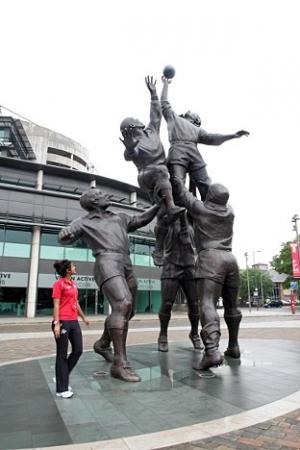
10:24am Wednesday 2nd June 2010 - By Joanna Kilvington
While rugby players are known for their statuesque physiques a new five-tonne sculpture has left them in its shadow.
The 27ft tall bronze sculpture, depicting a rugby line-out, will welcome fans to Twickenham Stadium from its spot on the South Stand piazza.
It is set to be seen by millions across the world as the stadium prepares to host the opening and final matches in the 2015 Rugby World Cup.
Created by Pop artist and sculptor Gerald Laing, the bronze of five rugby players was unveiled at a ceremony on Friday, attended by Richmond Council leader Nick True and rugby stars, including England team manager Martin Johnson.
Engraved around the bottom of the statue are the five core values of the game of rugby union - teamwork, respect, enjoyment, discipline and sportsmanship - to ensure they have a lasting legacy at the home of England rugby.
"We've dedicated it to the core values of our sport."
It is the fifth sculpture created by Mr Laing for the stadium and marks the completion of the South Stand development. His other four sculptures have adorned the entrance to the West Stand for more than 15 years.
Costing £455,250, the sculpture was originally created in clay, scanned on to a computer and set in bronze by the Black Isle Bronze foundry in Scotland.
It made the journey to the stadium in a lorry and trailer, which was stopped three times by police.
Mr Laing thanked the RFU for once again choosing him to create an iconic sculpture at the stadium and said he chose to depict a line-out as it was a "particularly dramatic" part of "the most dramatic of games".
He said: "I thank the RFU for having the courage and conviction to commission this sculpture."
He compared the potential catcher to Knight of the Round Table, Sir Percival, on the quest for the Holy Grail.
However, unlike the knight's success it remains unclear if the rugby player has caught the ball or not.
The statue impressed Mr Johnson, who despite being 6ft 7in, only came up to the waist of the standing players in the sculpture.
He said: "Sitting there you couldn't judge the scale of it. It's impressive."
Council leader Nick True said: "It's fantastic. I'm hugely impressed. It will be considered a great bit of art for generations to come."
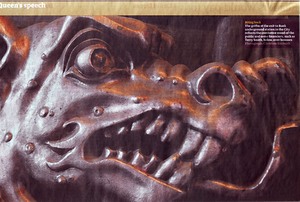
from The Guardian, Financial, Thursday 17 November 2009
The Griffin at the exit to Bank underground station in the City reflects the combative mood of the public...
Photograph: Christian Sinibaldi
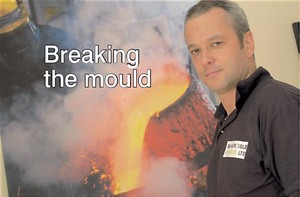
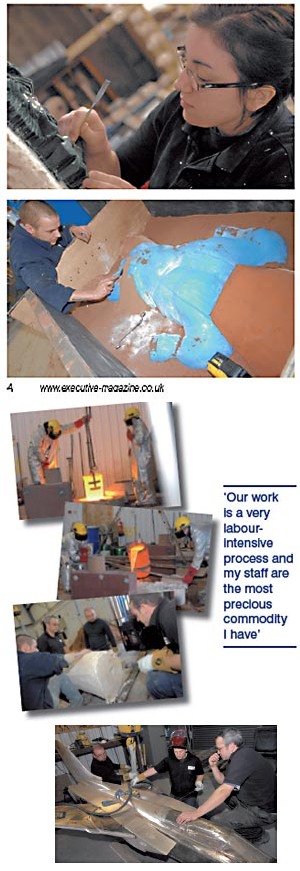
from The Executive magazine - November 2009
It may be the home of English rugby but Twickenham has a decidedly Scottish flavour thanks to a Nairn based company.
When the stadium hosts the prestigious Guinness Premiership final next May, Twickenham’s famous plaza will feature a spectacular bronze sculpture depicting a rugby line out featuring five, twice life-size players.
The cast will be the work of Highlander, Farquhar Laing and his team at the Black Isle Bronze foundry.
“This is a big commission for us,” Farquhar told Executive.
“It should take around seven months to complete and it will be in place at the end of May 2013 in time for the Guinness Premiership final. England will also be hosting the Rugby World Cup in 2015 so the eyes of the world will be on Twickenham.”
This latest commission brings Farquhar full circle as his first major project after setting up Black Isle Bronze in 1994 was also for Twickenham.
At that time the stadium was being re-built so Farquhar took the bold decision to contact the owners directly and offer his services.
Today, his work takes pride of place at the entrance of new Twickenham in the form of four heroic-scale rugby players.
“I wrote a letter to the rugby union asking if they would like to have some bronze statues done for the new stadium and I followed it up with a phone call – if you don’t ask, you don’t get! They called me back and said I was the only person who had contacted them about it.
“I was 24 years old and within two months of starting my own business I’d landed this massive commission – I was over the moon! I thought running my own business was going to be easy.”
Farquhar is the first to admit that there have been some “scary moments” in the past 15 years but in spite of some hiccups, the business has proved to be a genuine Highland success story.
In the face of competition from larger, southern based foundries, Black Isle Bronze has won a host of major commissions from around the world ranging from private orders to public works including a memorial plaque at the Somme village of Contalmaison, France, The Mare and Foal, Chukyo Racehorse Owner’s Association, Tokyo, a statue of 19th century mathematician and physicist James Clerk Maxwell in George Street, Edinburgh, bronze work for favourite celebrity haunt, The Ivy restaurant, Soho and all 66 castings for the exterior of the impressive, eight-story Robert Adam landmark development at 198–202 Piccadilly, a prime location in one of London’s most prestigious thoroughfares.
Earlier this year a bust of football legend Sir Bobby Robson was presented to Newcastle United FC shortly before Sir Bobby passed away in August. Other works have included a bust of the late Luciano Pavarotti, a tribute to Jack Walker, benefactor of Blackburn Rovers FC, a statue of jockey, Frankie Dettori at Ascot and more recently the Royal Warrant for British couturier,
Burberry to name but a few.
However, a Highlander born and bred, Farquhar has not forgotten his local roots and has created stunning works which are now a permanent part of the Highland land and town scapes they occupy, most notably The Emigrants at the Clearances Centre in Helmsdale, Sutherland, the Falconer at Eastgate II and a tribute to Highland Olympians in Aviemore. The business is currently working on a sculpture of a Tornado fighter jet which will take pride of place at Forres Enterprise Park marking Moray’s long connection with the RAF at Kinloss and Lossiemouth.
The scale of works carried out by Black Isle Bronze is staggering given that the team is just nine-strong, including Farquhar, and it's purpose-built foundry is based in the Highlands.
However, Farquhar puts the business’s success down to the two vital qualities – reliability and the dedication of his staff.
“What we do is very simple, we never miss our deadlines. A lot of the work is for special anniversaries or occasions so delivery time is very important.
Reliability is everything.
“We’re also very flexible. I have a great team here who will come in and do the extra hours to get the work done on time and get over the finish line.
“Our work is a very labour-intensive process and my
staff are the most precious commodity I have.”
As the name suggests, Black Isle Bronze started out on the Black Isle, at Kinkell.
At that time, Farquhar was based in a disused farm steading that, come winter, snowed on the inside!
But after securing lucrative commissions and with support from Highlands and Islands Enterprise, the business moved to its purpose-built foundry and workshop at the Balmakeith Business Park, Nairn in 2002.
The move was a huge investment by the business but one that has allowed Black Isle Bronze to literally make its mark at home and abroad.
“The war memorial at the Somme was one of the most interesting destinations you could wish for,” said Farquhar.
“It’s a place where so many people were killed during the war – including relatives of mine – so to leave a lasting legacy there and in my home town, as a professional, is great. The job satisfaction is 100 per cent better than in any other job, Bronze is one of the few permanent mediums that exist.
The oldest bronze statue in the world is about 3,000 years old so we can safely give a 3,000-year guarantee for our work!”
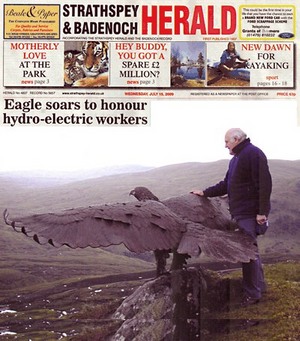
Wednesday, July 15, 2009
A MAJESTIC bronze eagle by a Strathspey sculptor has been given a home perched high above a £160 million green energy scheme in a Highland glen.
The giant golden eagle was commissioned as a tribute to the 3,300 workers who toiled for three years to build the hydro-electric power scheme - the first of its kind in Scotland in over half a century - at Glendoe, near Fort Augustus.
With a wing span of 12 feet, and weighing more than half a tonne, the sculpture is the creation of Boat of Garten artist Tom Mackie.
It is one and a half times life-size, and has been set into natural rock above the dam, which was offically opened by HM the Queen on June 29 this year. At around 2,500 feet above sea level, it is thought to be the highest wildlife sculpture in Britain.
Mr Mackie worked with Nairn-based specialist foundry Black Isle Bronze to produce the stunning sculpture, which commands a bird's eye view over the 100 megawatt development.
"The foundry approached me to do the piece; I had never done anything that size before, and it was a pretty exciting project to work on," said the 70-year-old.
He began by crafting a smaller model eagle with outspread wings, before scaling up the design and creating the intricate wax form from which the bronze eagle was cast.
The whole process took around six months, and last Tuesday Mr Hackie and his wife, Isabel, travelled to Glendoe to unveil the eagle to workers at the Scottish and Southern Energy (SSE) scheme.
"It was a very proud moment - it was really very moving having everyone up there and seeing the eagle finally set into the rock," said Mr Mackie.
"Then just as we were about to leave the estate, we spotted a real golden eagle soaring overhead. That really was very special."
Foundry specialists had considered creating a base to secure the eagle high on the mountain. However, geologists working at Glendoe found a rock overlooking the dam which proved a perfect natural perch for the work of art.
"The wind up there can be fierce. and they needed to be sure that the eagle would stay held fast to the rock in all weathers," Mr Mackie explained. "I think it is a very fitting tribute to the guys who worked up there in all weathers over the past three years. The foundry made a superb job, and I think everyone is delighted with the results."
Since moving to the Strath more than 40 years ago, Mr Mackie has drawn inspiration from the Cairngorms landscapes, studying local wildlife and sculpting detailed and lifelike deer, salmon, horses and dogs, as well as human figures.
Born in Edinburgh in 1939, he attended Leith Academy before serving a five-year apprenticeship and qualifying as a master mould-maker with A.W Buchan. He has made models since he was five years old, and his love of wildlife inspired him to make sculptures professionally.
The cost of his latest creation has not been revealed.
Closer to home, examples of Mr Mackie's work are on display and sale in Mortimer's anglers and outdoor store on Grantown's High Street, and at the Speyside Heather Centre.
The Glendoe hydro scheme was massive undertaking that involved creating a huge reservoir and tunnelling through solid rock for over five miles into the mountain landscape above Loch Ness.

By Jonathan Brocklebank of the Daily Mail - Friday December 26, 2008
PERCHED in the garden, he’ll be the first to know when a hard rain’s
gonna fall or if it’s a good day to have washing blowing in the wind. For
this is rock legend Bob Dylan as he has never been seen before, cast in bronze
and appearing all year round on British turf – whatever his touring commitments elsewhere.
The life-size statue of the seated singer playing his guitar is among the more
unusual recent projects completed by Black Isle Bronze, a Highland foundry which
has built its business on immortalising heroes.
The statue was produced at a cost of many thousands of pounds for clients Yve
and Steve Freer who are huge fans of the star.
Other private clients of foundry owner Farquhar Laing have included the late
Italian tenor Luciano Pavarotti, who ordered a bust of himself, and Scottish comedian
Rory Bremner, who wanted a statue of Merlin.
Meanwhile, multi-millionaire client Felix Dennis has a ‘garden of heroes’
populated with more than 30 statues cast in Mr Laing’s foundry in Nairn.
These include Shakespeare, Van Gogh and the poet William Blake – while the
latest bronze on order is engineering icon Isambard Kingdom Brunel.
At a time when businesses all over Britain are tightening their belts, Black
Isle Bronze is expanding, thanks to a stream of orders from wealthy clients which
will keep staff busy for at least a year. Mr Laing, 38, whose father Gerald is
a highly-respected Scottish artist, said: ‘Basically, our work is about heroes.
Whether that’s in sport, music, the battlefield or whatever, the fact that
they’re heroes is what unites them all.’ Among the other casts completed
in the last few years are statues of champion jockey Frankie Dettori and the first
four-minute mile runner Roger Bannister.
But private commissions such as the Bob Dylan statue, which has taken pride of
place in a Warwickshire back garden, illustrates the extent to which the demand
for bronze icons has spread well beyond town squares, civic buildings and museums.
‘We have a long list of private clients who want to make some sort of statement,’
said Mr Laing. ‘We are working for a very wealthy American client in New
York to make a large World War One monument.’ The statue of Dylan was sculpted
in clay by James Butler, one of Britain’s most renowned sculptors. A plaster
cast of it was then transported to Nairn for the figure to be cast in bronze,
a complex process which can take up to three months to complete.
Moulds of the sculpture are taken using liquid rubber which solidifies around
the figure. Those are eventually turned into boxes into which molten bronze from
the foundry is poured. When it cools it should produce an exact replica of the
original sculpture.
Mr Butler, one of the country’s most sought-after sculptors, charges £30,000
to £40,000 for most life-size figures. Casting them in bronze adds £11,000
to the bill.
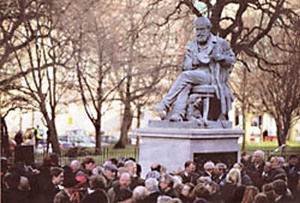
from The Scotsman, Nov 26 2008 - By John Ross
THE company responsible for creating Edinburgh's newest landmark has announced
major expansion plans.
Black Isle Bronze, based in Nairn, produced the huge bronze figure of 19th century
mathematician and physicist James Maxwell, which was unveiled in George Street,
yesterday.
The firm which casts figures up to twice life-size, ranging from historical characters
to modern-day sports personalities plans to install a bigger furnace, making it
the largest foundry of its type north of Birmingham.
Farquhar Laing, 38, the son of artist Gerald Laing, set up the company in 1994.
He began the business as a one-man band, with just £200 for materials, but
now employs a staff of eight, and has orders booked for the next year and an expansion
plan costing £43,000.
Mr Laing said: "We already have the largest melting capacity of its type
in Scotland, but this expansion will double our melting, putting us on a par with
the largest English foundries.
"This will enable us to be more competitive with our larger counterparts
south of the Border, and complement the skills that we have here which are in
huge demand. Once this expansion is complete,it's safe to say we will be the largest
foundry of this type north of Birmingham.
Our goal is to maintain and enhance what we do already."
The company cast The Falconer statue, by sculptress Leonie Gibbs, for the Eastgate
Centre in Inverness.
Other commissions to date include castings of sporting figures for Royal Ascot
racecourse, Haydock Park, Twickenham rugby stadium, the new Wembley stadium, Lords
cricket ground and four English Premiership football stadia.
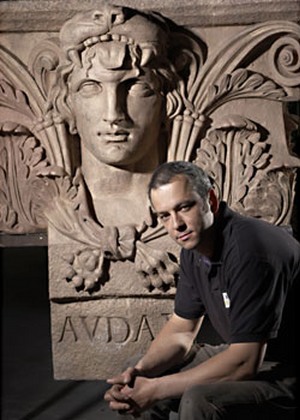
from The Press & Journal, Nov 26 2008
Nairn foundry is thinking even bigger
BLACK ISLE BRONZE UNVEILS £43,000 EXPANSION PLANS
THE Nairn foundry that cast two iconic Highland statues yesterday unveiled
£43,000 expansion plans.
Since it was established in 1994, Black Isle Bronze has also been commissioned
to cast bronze statues of sporting heroes at Ascot, Haydock Park, Twickenham and
Wembley.
With business booming and demand for double life-size castings growing, the company,
which employs eight staff at its base in Balmakeith Business Park, is to install
a larger furnace.
The firm's £43,000 expansion plans are being backed with a grant of more
than £10,000 from Highlands and Islands Enterprise.
Black Isle Bronze founder Farquhar Laing said: "This expansion will not only
enable us to be more competitive with our larger counterparts south of the border,
it will also complement the skills that we have here at Black Isle Bronze, which
are now in huge demand.
"Once this expansion is complete, it's safe to say we will be the largest
foundry of this type north of Birmingham. Our goal is to maintain and enhance
what we do already."
Two of the company's bronze castings in the Highlands include The Falconer, by
Leonie Gibbs, at the Eastgate Centre in Inverness, and The Emigrants, at the Clearances
Centre, Helmsdale.
Future commissions include two double-life size statues for Newcastle United Football
Club and monuments to engineer Isambard Kingdom Brunel and athlete Roger Bannister,
the first runner to break the four minute mile.
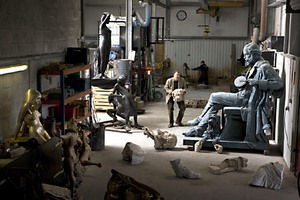
from The Guardian, Nov 21 2008
A statue of James Clerk Maxwell, Scottish mathematician and
physicist, by sculptor Alexander Stoddart at the Black Isle Bronze foundry at
Nairn in the Highlands.
Photograph: Murdo Macleod
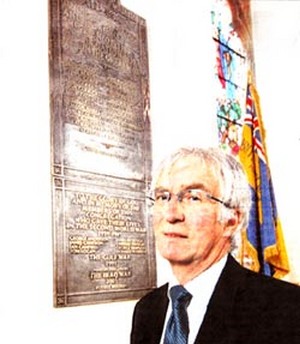
from The Highland News Group, Aug 30 2008 - By Stuart Taylor
HOW quiet the former Macintosh Memorial Church of Scotland seems, perched high above
Fort William town centre.
A year ago it was so different.
The congregation was in the throes of flitting to its new home in the Duncansburgh
Church on The Parade.
This entailed disposing of many items of furniture including the Communion Table
which went to its new home in
the Free Church of Scotland in the town's West End.
However, there was a plaque on the table to the memory of members of the MacIntosh
congregation who had been killed in the 1939-45 war.
This "loss" has been rectified as a new plaque has been made. "Actually
it will not be totally new, rather a mix of the new and old," said Rev Donald
MacQuarrie, minister at the Duncansburgh MacIntosh Church of Scotland.
"The style of the 1914-18 plaque has been used to create an extension incorporating
the 1939-45 names and also including details of the two Lochaber young men who were
lost in the more recent conflicts in the Gulf and in Iraq.
"The resulting plaque is most impressive, the work of Black Isle Bronze Ltd."
On Sunday, August 31, this new war memorial plaque will be dedicated in the Duncansburgh
MacIntosh Church.
Family and friends of those commemorated in the memorial are welcome to attend
the service or to visit the church at another time.
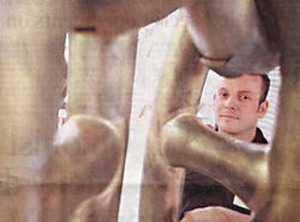
from The Press & Journal, June 12 2008
THIS year's Nairn Book and Arts Festival is in full swing with a busy programme
of exhibitions and visits by a star-studded cast of writers, artists and musicians.
But casts of another sort were the centre of attention as Black Isle Bronze, the
UK's leading fine art, architectural and memorial foundry, opened its doors to
festival goers. About 35 visitors were shown round by proprietor Farquhar Ogilvie
Laing.
He told them about the history of the foundry and its work in using wax and sandcasting
techniques to translate forms from clay to bronze.
The guests were able to see the entire process from mould to finish and patination.
Bronze chaser - or metal finisher - Ian Forbes demonstrated his work on a set
of giant chain links, which will be part of a forthcoming sculpture of Isambard
Kingdom Brunel.
Artist Jim Butler is creating a bronze of the famous engineer from a photograph
of him standing against a background of chain links.
So far, only the links have been cast, five rows of five and-a-half links. The
foundry expects to receive the form of Brunel later this year.
Among Black Isle Bronze's recent commissions is the Nairn fisherwoman sculpture,
which was unveiled during Highland 2007 and now stands on the town's harbour wall.
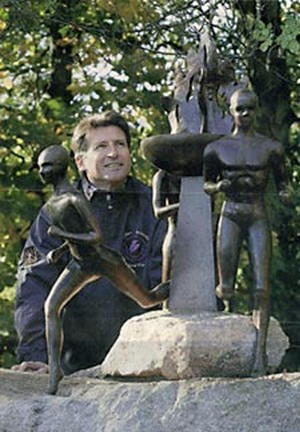
from The Press & Journal, October 17 2007
ONE of Britain's greatest athletes unveiled a tribute to Highland Olympians
yesterday while their supporters rallied to ensure other local talent would have
the same chance to flourish.
Gold medallist runner Sebastian Coe, now Baron Coe, took centre stage in Aviemore's
Main Street, where hundreds of villagers gathered to honour 14 of the area's finest
sports achievers - most present for the occasion.
Their names now adorn a bronze sculpture standing proudly on the village green.
The £36,000 creation, resplendent with Olympic flame and mounted on Cairngorm
granite, represents the Olympic ideals of "faster, higher, stronger".
For some, the artwork of Inverness-born Dudley Evans is symbolic of an era when
climate change poses a challenge to future winter-sport greatness.
Watersports entrepreneur Clive Freshwater, whose Olympian skier son, Andrew, is
honoured, said: "It's a proud day because I wouldn't think there's a city
or town in the country with as many Olympians as the Spey Valley.
"Sadly, with the poorer skiing, it's going to be a bit harder to produce
Olympians."
Skier Ingrid Grant said: "The winters are milder than when we were younger
and it means that our youngsters are going to have to find extra funding to travel
abroad and make use of the better snow conditions abroad."
Nordic skier Louise MacKenzie, 43, another of the elite, shared this concern.
"When we were younger, we had snow from October through till May," she
said.
Staggered by the valley's sporting prowess, Lord Coe. who is chairman of the London
2013 Games organising committee, said: 'This is an extraordinary story: a population
of barely 10,000 people producing per head of the population so many talented
people. I don't know what you're doing but, for God's sake, don't stop doing it
because it's clearly working."
Community leaders, keen to maintain the area's success rate, have organised a
public meeting for Monday to draft proposals to re-establish facilities that the
resort lost with the demise of the original 1960s-built Aviemore Centre.
Badenoch and Strathspey Sports Council is hold a meeting at the Cairngorm Hotel,
Aviemore, at 7.30pm.
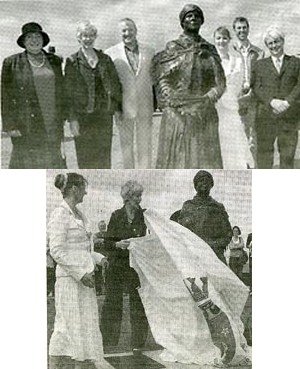
from The Nairnshire, August 7 2007
Highland 2007 has been made manifest in Nairn with the unveiling last weekend
of a statue of a traditional fishwife.
The statue is based on an actual person, Annie Ralph, one of the last of the Nairn
fishwives who carried fish in a creel on their backs " to sell in Nairn,
Nairnshire and beyond.
Upwards of 300 people gathered at the Harbour to watch Annie Ralph's great
niece, Janet Urquhart, perform the unveiling.
Ms Urquhart was introduced by Provost Liz MacDonald who initiated the statue project
when she realised that money allocated to Nairn for the Highland Year of Culture
2007 was unlikely to be spent. The statue has cost £37,500 with HIE (£8000)
and The Nairn Fund (£1000) also contributing. The Lottery put up £10,000.
The provost was already familiar with the life-size photo cut-out of Annie Ralph
which is on display at Nairn Museum. Museum volunteers collaborated on the project,
ensuring that the statue was historically accurate and even providing some of
the textiles used in the creation of the figure.
The sculptors were Ginny Hutchison and Charles Engebretson from Aberdeenshire
and the statue came home to Nairn to be finally cast at Black Isle Bronze's Balmakeith
works.
"I was delighted that we kept some of this money in Nairn", Provost
MacDonald told the Nairnshire. " I love the statue," she added, noting
that community involvement had been "fantastic".
By chance, Janet Urquhart - from Wellington, New Zealand - had visited Nairn Museum
where she heard about the project. "I was researching, going back looking
for more Ralphs. The people at Nairn Museum were just wonderful, providing me
with information. It was mentioned that there was going to be a statue based on
Annie Ralph."
Nairn Museum director Alan Barron then mentioned to the Provost that a relative
of Annie Ralph might be available to perform the unveiling.
Janet Urquhart continued: "Annie was my great, aunt, my grandfather's sister.
My grandfather was George Ralph and their parents were George Ralph and Margaret
Wilson. We were all born out in New Zealand but we have had lots of people from
the Fishertown out to visit us so I have grown up with Nairn all my life.
"I don't quite believe that this is happening and that I was asked to unveil
the statue. My Mum and all of them would be just so proud!"
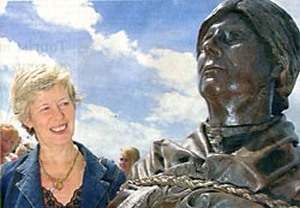
The Press & Journal - 6 August 2007 - BY SUSY MACAULAY
GREAT-NIECE AT CEREMONY AFTER SEARCH FOR FAMILY
A BRONZE statue inspired by a local fisherwoman was unveiled in Nairn on Saturday.
Around 800 people gathered to see the new addition to the harbour. The statue
stands over 6ft tall and carries a basket bearing butter, eggs, gutted fish and
scales.
It is the brainchild of Nairn provost Liz MacDonald, who was determined
to use a local under-spend for the benefit of the town.
She took as her inspiration for the statue a lifesize photograph in the local
museum of young fisherwoman Annie Ralph.
Local company Black Isle Bronze was commissioned to create the statue, designed
by artists Ginny Hutchison and Charles Engebretson.
By coincidence, a great-niece of Annie Ralph was visiting the area trying to track
down her ancestors.
New Zealander Janet Urquhart had approached Highland Council for help
in tracing her grandfather, George Ralph, and was astonished to find herself invited
to unveil the statue of her great-aunt.
Mrs MacDonald, who voluntarily managed the project, said: 'It was an emotional
occasion. A lady approached me in tears because seeing the statue reminded her
of the past.
"I am so pleased that the statue was made locally.
"Black Isle Bronze make many works which are shipped all over the place.
It's good to have one of their pieces in Nairn itself."
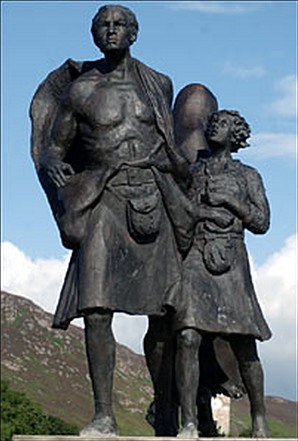
As shown on BBC News 24 website - 23 July 23 2007
The statue commemorates people who were cleared from the area.
A memorial statue to those affected by the Highland clearances has been officially
unveiled.
First Minister Alex Salmond attended a ceremony to remember the clearances in
Helmsdale, on the Sutherland coast.
The 10ft-high bronze "Exiles" statue commemorates the people who
were cleared from the area by landowners and left to begin new lives overseas.
Canadian mining millionaire Dennis Macleod, who was behind the scheme, also attended the ceremony.
The statue, which depicts a family leaving their home, stands at the mouth
of the Strath of Kildonan and was created by Black Isle sculptor Gerald Laing.
Mr Salmond said: "This statue is not only a reminder of the Highland clearances,
but a great example of the skill and vision of those who remain.
"This statue is a reminder of the men, women and children who left Scotland
and took their skills, their strength and their stories across the seas and shared
them around the world. While we deplore the clearances we can be proud of the contributions
that those cleared have made to humanity."
The original plan for a commemoration by a group of campaigners was to obtain
permission to knock down a controversial statue of the laird involved in the clearances,
the Duke of Sutherland, which towers over the town of Golspie.
Modern city
Although this never happened, they got together with Mr Macleod, who was born
in the much-cleared Strath of Kildonan.
He set up a Clearances Centre which commissioned the statue now in place.
An identical one has also been set up on the banks of the Red River near Winnipeg
- the modern city founded by those who left Scotland for Canada.
Mr Macleod told BBC Scotland: "It's my personal ambition to have the same
statue erected in all of the areas where the Highlanders settled. We now have two and I can see five or six eventually, in places like
Canada, the States and Australia."
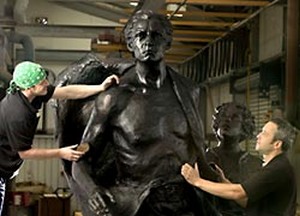
NAIRN FIRM'S WORK ERECTED IN WINNIPEG
BY SAMANTHA CHETWYND - from the Press & Journal, June 11 2007
A huge statue made by a Highland-based foundry has been put on show in a Canadian
city.
The 10ft statue of a Highland Clearance family, made by Black Isle Bronze, based
in Nairn, has been unveiled in Winnipeg.
Based on the famous work, the Emigrants - the statue of a man, boy and woman carrying
a baby - was commissioned by the St Andrew's Society, from the Canadian town.
The Highland Settlers Monument is located on a roundabout in the centre of the
city, a few yards from the riverbank in the area where the emigrants first arrived.
Due to an unstable riverbank the original location, on the riverbank, had to be
scrapped.
Kamila Goudie, spokeswoman for St Andrew's Society, said the monument would be
seen by thousands of people every year.
"Its role is to commemorate the Clearances and the Winnipeg Settlers, and
to educate the public on how the terrible eviction that took place in Scotland
was the genesis of our city," she said.
Farquhar Laing, owner of Black Isle Bronze said: 'This has been a huge and culturally
very important project to work on. The statue will play a key role in the history
of Winnipeg, Canada and also Scotland. It also provides further proof that we
are able to service international markets from our Scottish base and we are clearly
one of the UK's leading foundries."
The Scotsman 2 June 2007 by JOHN ROSS
IN SCOTLAND they were emigrants, victims of the Highland Clearances who left to
find a new life across the Atlantic. In Canada, they were settlers, early residents
who established colonies that are part of the country's heritage.
The link between the two has been marked this week with the arrival in Winnipeg
of a replica of a larger-than-life statue of a Clearance family.
The 10ft high sculpture of a man, a boy and a woman carrying a baby was commissioned
by the St Andrew's Society in Winnipeg and is based on The Emigrants, a well-known
work that is displayed in a park in Helmsdale, Sutherland.
The replica, called the Highland Settlers Monument, will be erected this
summer on a prominent roundabout in cental Winnipeg, a few yards from the riverbank
in the area where the Scots emigrants first arrived.
The St Andrew's Society in Winnipeg was founded in 1871 and now has about 400
members. Kamila Goudie, its spokeswoman, said: "Since the monument will be
located in the middle of a busy intersection, we estimate every year thousands
of people will see and visit it.
"Its role is to commemorate the Clearances and the Winnipeg settlers, and
to educate the public on how the terrible evictions in Scotland were the genesis
of our city."
The three-tonne statue, which took about four months to complete, was created
by Black Isle Bronze, which cast the Helmsdale sculpture in 2003. Farquhar Laing,
the foundry owner, described the project as "culturally very important".
The first settlers arrived in Canada in 1812 in areas at the junction of the Red
and Assiniboine rivers in Winnipeg, many of them from Kildonan in Sutherland,
one of the areas worst affected by the Clearances.
They were helped by Thomas Douglas, the fifth Earl of Selkirk, who received a
large grant from the Hudson's Bay Company to recruit workers for the firm.
The original statue in Sutherland was at first to be 30ft high and form part of
a 120ft high monument to be erected on a hill near Helmsdale and rival the statue
of the Duke of Sutherland which overlooks Golspie.
However, the project was scaled down after it was discovered that original cost
and time estimates would be significantly exceeded.
One of the backers of the original statue was Dennis MacLeod, a former gold mining
tycoon whose family was evicted from Sutherland.
He has also supported the project in Canada, where he now lives.
jross@scotsman.com
More Info
www.standrewssociety.mb.ca
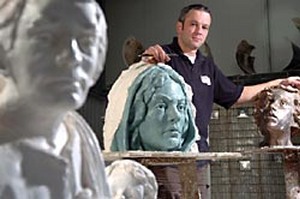
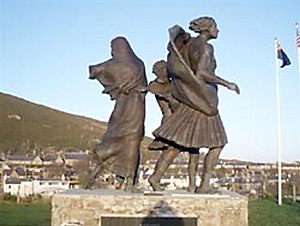
The Press & Journal March 13 2007
A HUGE bronze statue of a Highland Clearances family is to be cast in Nairn
and shipped out to Canada.
The 10ft figures of a man, a boy and a woman carrying a baby will be a replica
of a 30ft statue designed as part of a 120ft monument commemorating the heritage
of the Highlands that was to have been erected on a hill near Helmsdale, in Sutherland.
The project, initially expected to cost around £5million, was dramatically
scaled down after it was discovered that original cost and time estimates would
be significantly exceeded.
Instead, Clearances Centre limited (CCL) offered Helmsdale and District Community
Council a 10ft version of the statue, known as The Emigrants, which stands in the village's Couper Park.
And Black Isle Bronze, which cast the Helmsdale monument in 2003, has now been
asked to create an identical statue for the St Andrew's Society in Winnipeg.
Farquhar Laing, 37, established the foundry in 1994 on the Black Isle before moving
into purpose built premises on the outskirts of Nairn in 2002 with the help of
a development grant from Highlands and Islands Enterprise.
The company now employs eight full-time members of staff, including two metal
workers, a mould maker, a welder and sand moulder, with the most recent recruit
joining the foundry from Poland.
"We're delighted with the commission. It's a big piece involving four tonnes
of bronze. We're especially pleased to be picking up work from across the Atlantic.
"There's also a possibility of another replica memorial being commissioned
by an organisation in Nova Scotia," said Mr Laing.
He added that it was one of their largest commissions to date and would take about
four months to complete.
The replica of The Emigrants, to be called the Scottish Highland Settlers Monument,
will be unveiled in Winnipeg this summer.
The foundry is also working on two statues for Newcastle Football Club of Alan
Shearer and Jackie Milburn, and a statue of Bob Dylan for a private client.
A recently-completed commission saw the Highland company collaborate with sculptor
Sandy Stoddart and British builder Sir Robert McAlpine on a Robert Adam designed
building in Piccadilly, London.
Black Isle Bronze supplied all 66 cast bronze elements of the eight-storey structure.
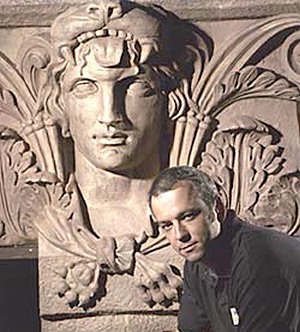
by Eilidh Davies, The Press & Journal September 5 2006
A HIGHLAND foundry has been signed up to contribute to a landmark London development.
Black Isle Bronze, who are based at Nairn, have won a contract worth hundreds
of thousands of pounds to supply 66 bronze sculptures which weigh up to a third
of a tonne. They will be used as decorative details on various parts of a new
office and retail space being built in Piccadilly by Sir Robert McAlpine.
The building, which has been designed by internationally renowned Robert Adam
Architects, will provide 70,000 sq ft of office space and nearly 30,000 sq ft
of retail space for the developers, Standard Life Investments.
Farqhuar Laing, founder of Black Isle Bronze, said: "It is a major coup for
our company to be contracted for what is one of the most important building works
in London at present.
"Our quality of work and the fact that our facility is the only one of its
kind in the UK were major factors in securing such a notable contract.
The pieces
themselves have been designed by Scottish sculptor Alexander Stoddart.
"We already have bronzes all over the world in countries such as Ireland,
South Africa, Japan and the US. Now our work will feature on one of London's key
landmarks. The contract has enabled us to employ two new people and we are in
line to produce bronzes for other important projects in England and elsewhere."
Robert Adam, of Robert Adam Architects, said: "The bronze sculptures on our
building in Piccadilly combine fine art and building craft.
"The quality of the bronze work is vital to their success. We are delighted
to be working with Black Isle Bronze to ensure the highest standards of craftsmanship.
The combination of a Paisley sculptor and a Nairn foundry brings the art and craft
of Scotland to the most important thoroughfare of London."
Black Isle Bronze have produced other notable key bronze pieces including a bust
of John Paul Getty II for the National Gallery, a statue of Jack Walker, the late
owner of premiership football club Blackburn Rovers which stands outside their
home ground, and a statue of Frankie Dettori which can be found at Ascot racecourse.
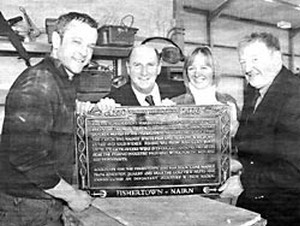
The Nairnshire Telegraph April 18 2006
Four new interpretive plaques have been commissioned for Fishertown as part
of a project designed to enhance the area's Conservation Area status.
The plaques have been commissioned with the assistance from the Little Theatre,
and the Yacht Club who provided the text for their plaques.
A further two plaques will shortly be put up outside the Laing Hall and at the
Harbour.
The plaques were manufactured by local firm Black Isle Bronze at the Balmakeith
Industrial Estate.
In addition a further three plaques which have lain in storage for 30 years will
be installed at the former Links school, Seaman's Hall and west end of Society
Street. Eight high quality benches have also been provided around the Fishertown
to enable people of all abilities to walk around and spend time discovering the
area.
Part of the project included the installation of the first phase of "heritage"
lighting in the area. The last part of this project will involve working with
the Nairn Museum to research the historic Nairn and it is hoped to work in association
with local schools to produce Fishertown leaflets and education packs.
Funding and assistance has been provided by Cllr Liz MacDonald, PRIN, Leader +,
Aggregates Levy Fund, Highland Council and Nairn Museum. The project has been
coordinated by The Nairn Fund.
Cllr MacDonald said "This project is a clear example of how local people
can work together to make a significant impact on their environment with the Council
assisting where possible.>
"I would particularly like to thank Bruce Barren of the Nairn Fund and Bill
Forrest from PRIN for enabling this project to go ahead. It is great that a project
started 31 years ago under the District Council is finally coming to conclusion,
but we must always be looking for ways to improve and enhance our environment
and involve the local community wherever possible"
Bruce Barren said "The Nairn Fund was delighted to act as the coordinators
of the project and we look forward to supporting similar projects in the future."
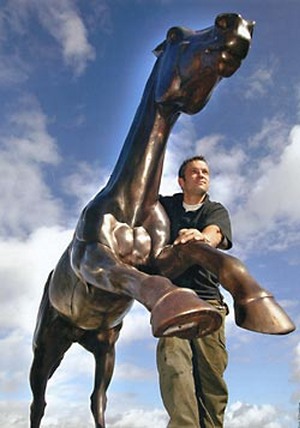
Bruce Stannard - Scots Magazine
Farquhar Laing's reputation for excellence precedes
him around the world these days, so it was no great surprise recently when the
telephone rang at his foundry and a politely-spoken Japanese gentleman introduced
himself and explained that he and his colleagues wished to fly all the way from
Tokyo to meet him and discuss business.
The four-man Japanese delegation duly arrived and was so impressed by the young foundryman's personal and professional integrity,
the quality of his work and his new premises in the Highlands, that they placed
entirely in his hands, responsibility for what was to become one of the biggest
and most important pieces of equestrian sculpture to be exported from Britain
in many years; the magnificent life-size sculpture of a thoroughbred mare and
her foal; that now commemorates the 50th anniversary of the Chokyu racecourse
in Tokyo.
Farquhar Laing met the Japanese delegation
in the Dorchester Hotel in London and subsequent invited them to come to Scotland.
"The Japanese came here and described the kind of sculpture they wanted,"
Farquhar says. " They were meticulous in every detail and they had sufficient
confidence in our reputation to leave the project entirely in my hands. We signed
contracts and I then had to find and commission the best sculptor for the job.
In this case it was the Englishman, Philip Blacker.
We then had to cast and
finish the work and ship it off to Japan. It was a fantastic commission. The Japanese
were extremely pleased with the result and not least because we did what we said
we would do, and that was to deliver precisely what they wanted, on-time and on-budget.
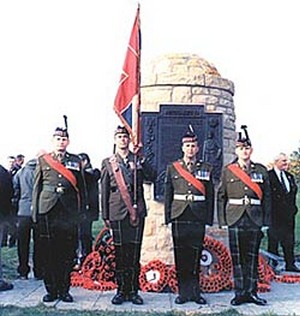
The latest memorial in France pays homage to the 16th Royal Scots and completes a ninety year circle, writes Jack Alexander in the Scottish Legion News (much abridged).
July 1st 1916 was the British Army's blackest
day. As the bloody Battle of the Somme struggled underway, it was an Edinburgh
battalion - the 16th Royal Scots, commanded by Lieutenant-Colonel Sir George McCrae
- that achieved the deepest penetration of the enemy position.
Now, 85 years after it was first suggested, the McCrae's Battalion Memorial has
finally been built. On Sunday 7th November 2004 a crowd of almost 500 souls gathered
in the Somme village of Contalmaison to see the unveiling of a 14 foot high traditional
Scottish stone cairn.
The final stage of construction involved
the installation of 4 bronze plaques just 1 week before the ceremony. I travelled
out to France on the Rosyth ferry with Farquhar Ogilvie-Laing (owner of the Black
Isle Bronze Foundry in Nairn) and Alvin Scott (whose grandfather was killed while
serving with McCrae's).
We arrived in Contalmaison late on the Saturday afternoon. By dusk, with the sun
setting over the fields where the battalion sheltered from the Quadrangle machine-guns,
we had mounted the principal plaque and drilled fixing holes for the remaining
three. On Sunday morning none of these holes seemed to be in the right place.
Our drill died and I had to borrow a replacement from the deputy mayor of the
village. The return ferry trip was booked for that evening: we got back to Zeebrugge
by the skin of our teeth............
We intend to return to the village every year on 1 July in order to keep alive
the memory of McCrae's.
Jack Alexander is author of McCrae's Battalion, Mainstream,
paperback £9.99.
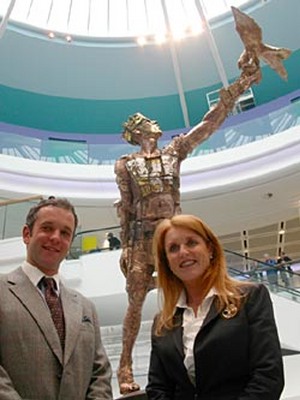
Black Isle Bronze owner, Farquhar Laing with Sarah, Duchess of York and Countess of Inverness.
The Duchess unveiled The
Falconer statue in May 2003 at the new Eastgate Centre, Inverness.
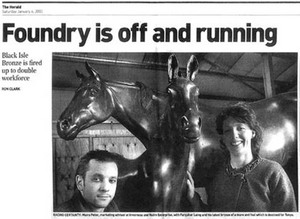
Article from The Herald - January 4 2003
The sparks are filling the air again as molten bronze is poured
into casting in a new foundry in Nairn, the first purpose-built plant of its kind
in the UK.
Black Isle Bronze has just opened for business after two years of work and planning
by specialist fine art foundry man Farquhar Laing, who marked the opening with
the finishing of a one-and-a-half ton bronze of a mare and foal for a Tokyo racecourse.
Orders for his bronzes – some up to 30 feet tall – are now arriving
at such a rate that he expects to double his workforce in the next three years
and build on this year’s turnover of £350,000.
He said at the new foundry, which was built with financial support form Inverness
and Nairn Enterprise and Adam & Co bank: “Most of our business so far
has developed through word of mouth. For instance, the Tokyo statue was ordered
when the Japanese customer saw one we had cast for Ascot Racecourse.
“Now, however, we have agents working for us to maintain a steady supply
of new work.”
Laing, son of respected sculptor Gerald Laing, established his first foundry in
his father’s garage on the Black Isle “until he told me to move out”.
Born in Inverness and schooled on the Black Isle, he moved to London to work for
Christie’s the auctioneers, but left soon afterwards to apprentice himself
to fine art foundries in England.
“I wanted to work with my hands, he said. “A lot of fine art foundries
are set up by failed artists, but I never wanted to be an artist. So I didn’t
have a lot of the ego problems that some foundry owners suffer from.”
His first commercial enterprise was set up in a steading in Nairnshire eight years
ago, when he determined that working to contract and “never missing a deadline”
would be at the core of his business philosophy. He said: “A lot of clients
are let down by foundries. It is a labour-intensive and time-consuming process,
and work schedules can slip. I want to make sure that doesn’t happen.”
As well as plaques and memorials, Black Isle Bronze began to attract large commissions,
particularly statues for sports grounds. It has completed two statues for Middlesborough’s
Riverside Park, a statue of Jack Walker for Blackburn’s Ewood Park, a statue
for Wolverhampton Wanderers, and a family group celebrating football for Sunderland’s
Stadium of Light.
Laing works closely with the sculptors, often sending his mould makers to work
on site at the artist’s studio. In other cases, the sculptor creates the
work in plaster, at which point it is shipped to Nairn for the mould-making process.
The moulds are made in sand and cured before being built into boxes, into which
the molten bronze is poured. The process can take up to three months, including
burnishing to attain the correct patina.
He said the undisclosed financial assistance from Inverness and Nairn Enterprise
had been dependant on job creation, but he said the fact that he was a manufacturer
helped. “I believe they were glad it wasn’t just another hotel or golf
course project.”
Black Isle’s current client list includes the National Gallery in London,
for whom Laing created a bust of one of its benefactors, Paul Getty. “It
stands in the museum entrance,” he said. “I think I am the only living
founder to have a work in the museum.” Others include comedian Rory Bremner,
for whom he cast an 18-inch high statue of Merlin, and New York diamond merchant
Harry Winston, who once sent the original Maltese Falcon to the Highland firm
to be copied.
The new foundry will cast the bronze for a 30-foot, unicorn-topped obelisk which
will mark the Mercat Cross at the Eastgate Centre in Inverness. Laing is also
undertaking his “biggest project ever” – a two-year commission
to cast a new work commemorating the Highland Clearances at a new £5m visitor
centre at Helmsdale.
The 30-foot statue, which will be sculpted by his father, has been compared to
the Statue of Liberty and the Colossus of Rhodes. It will depict a family group
being forced to flee Scotland.
The new foundry is insulated and has modern fume extraction, as well as overhead
cranes, moulding pits, kilns and flues. Laing said: “We are now working in
conditions which will enable us to produce excellent quality work and compete
with art foundries all over the world.”